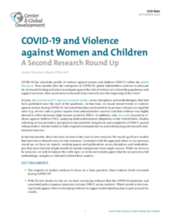COVID-19 has raised the profile of violence against women and children (VAW/C) within the global discourse. Nine months after the emergence of COVID-19, global stakeholders continue to advocate for increased funding and action to mitigate against the risk of violence on vulnerable populations and support survivors. How much have we learned from research since the beginning of the crisis?
In June, the authors summarized 17 rigorous research studies across disciplines and methodologies that had been published since the start of the pandemic. At that time, they found mixed trends in violence against women during COVID-19, but noted that data was limited by its primary reliance on reported rates (e.g. service calls or police reports from administrative sources) and that evidence was highly skewed to reflect dynamics high income countries (HICs). In addition, only one study focused on violence against children (VAC), analyzing child maltreatment allegations in the United States. Studies reflecting service providers' perspectives documented rising levels and complexity of VAW/C, paired with providers' limited ability to fully respond to demand due to social distancing and strained institutional resources.
In the last months, there has been no slow to the wave of new research. The authors round up 28 new studies that have been released since their last summary. Consistent with the approach taken in our previous round up, we focus on reports, working papers and publications across disciplines and methodologies that move beyond simple month-to-month comparisons from single sources. While we strive to be inclusive, we seek to balance this with rigor, so we do not include papers that do not present a full methodology, samples or indicators behind their analysis.

